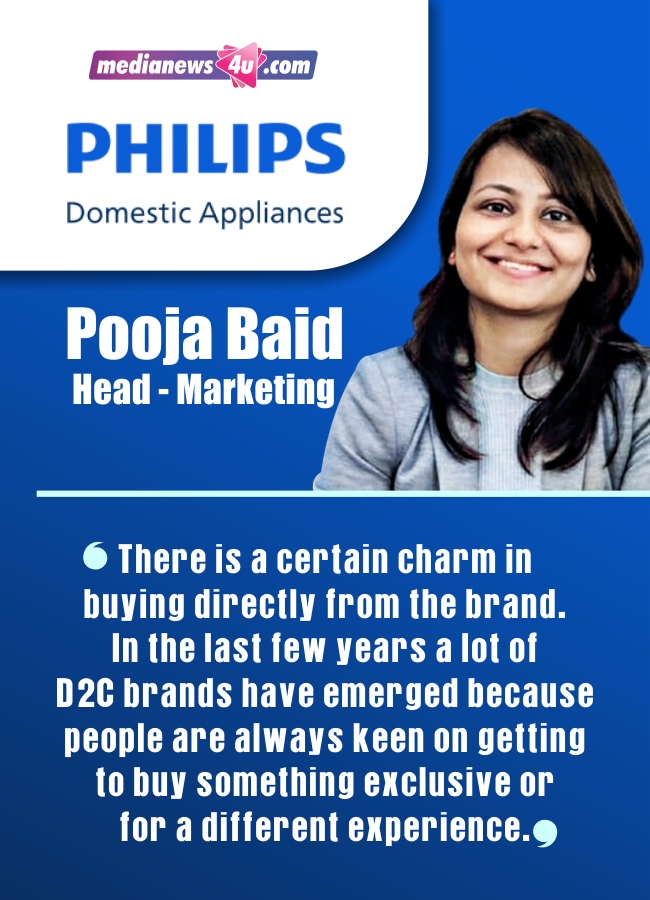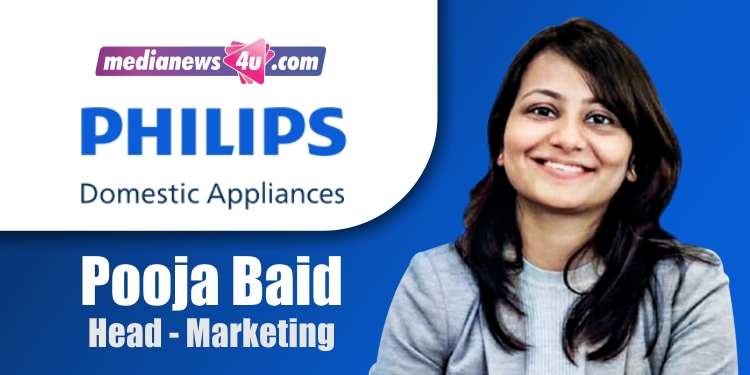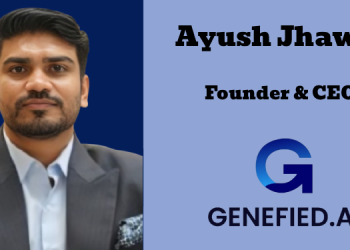Philips Domestic Appliances India announced the appointment of Pooja Baid as its Head of Marketing in October 2022. In conversation with MediaNews4u.com, Baid says that there is a trend of consumers leaning towards products that offer convenience and address pain points.
You have moved from Coca-Cola to Philips Domestic Appliances recently. How have the early days of the transition from beverages to appliances been and what are the challenges in your new role?
It’s actually from Philips to Coca-Cola and back to Philips. I had a stint with Philips India Limited earlier in my career for around seven and half years and then moved to Coca-Cola. Saying I am back won’t be right as Philips Domestic Appliances India and Philips India Limited are not the same. It has been a very interesting transition. Culturally, the two companies are very different.
Coca-Cola is a very stable company and there is a lot of opportunity to build a lot of marketing and consumer communication there. Philips gives the opportunity to dabble deep into business. They have a hunger for growth. The start with Philips this time has been incredible. Philips is an exciting place to be in and I am trying to learn a lot of things quickly.
It is said that India is a complex market for household consumer appliances. What are the key home appliance purchasing trends that you have observed in the last one year?
A lot of things have changed sharply in the last two years. The home-bound environment changed for a large section of people which is reflecting very deeply in the way they are purchasing appliances. Suddenly the need for convenience, time saving and smart appliances have gone up dramatically. While during Covid we would have noticed people were spending a lot of time at home and they wanted to indulge themselves in gourmet cooking, for instance. There was a rise in the need for gourmet cooking appliances.
Currently, we see a very sharp increase in categories like garment steamers. The category has doubled last year.
Most appliances that offer a superior level of convenience and have smart solutions to consumer problems are getting picked up. Categories like air fryers which have done very well during the Covid period are doing well even now. We also see an uptick for home improvement categories like vacuum cleaners. Philips recently launched a stick vacuum cleaner. Home appliances as a category has witnessed healthy growth.
What are the trends that you have seen pre and post pandemic in terms of online sales?
New shoppers have come to online platforms during the Covid period. The same is reflected in the home appliances industry and for brand Philips.
E-commerce sales have grown for us. However, since the market started opening up, people took the opportunity to step out and do a revenge kind of shopping. Because of that offline sales numbers have increased in 2022. Nevertheless, online and offline channels are doing well for Philips. We continue to maintain our shares in both channels, even post Covid.
With a lot of mobile phone and e-commerce penetration, people started to use the online platforms as a way for education and discovery. Every time they need to buy some they go online and read reviews. But will the consumer buy something entirely different offline and online? That is not the behavior either the consumer exhibits or is expected to exhibit in times to come.
Philips’ D2C platform is also working well for us. There are several experiences we provide for our consumers which might not be found on other e-commerce platforms. For example, we provide the opportunity to do a live conversation and demonstration of a product with the consumer. In general there is a certain charm in buying directly from the brand. In the last few years a lot of D2C brands have emerged because people are always keen on getting to buy something exclusive or for a different experience. Philips launched a compact product, a sneaker cleaner exclusively for the D2C platform. The launch added value to the brand and consumer engagement was also good. I believe that propositions like this excite consumers to visit D2C platforms.

Philips prides itself on innovation with the latest addition being a pressurised steam generator iron. Can you talk about the R&D focus of the brand?
If you look at it historically, the kind of innovation Philips have come up with, they are always deep-rooted in a consumer challenge that needs to be solved. We came up with air fryers which was never a concept during that point of time. We came up with a product called fabric shaver because we realised that it’s important for the consumers to keep their clothes preserved.
A lot of our R&D happens in Europe. We have a local innovation center based out of India which works on several relevant Indian products. For example, Philips was the first one to innovate on technology which allows you to have a mixer grinder and a food processor on the same device.
R&D is an ongoing process and we continue to identify the pain points and work on them.
Can you elaborate on your media mix and how it has changed?
Philips is pretty much the brand that sets the tonality for the industry. We are not just confined to the metros but also to reach consumers in Tier 1, 2 cities. Over the years, we have had a healthy presence in the TV and print. But very consciously, over the several years, we also indexed ourselves highly in favour of digital mediums because we realised it’s a high-engagement medium. Digital is a medium where consumers spend more time and give more attention to the communication they are receiving. There are two-way interactions possible on the digital medium. It is also a medium for discovery and education.
Over a 10-year trajectory, then focus on print and TV has gone down and digital has increased significantly.
There is a change in the way the home appliances communication is depicted. Previously, it was women who were seen handling the kitchen and now the narration has changed where men are also being a part of it. Your thoughts?
Home as a place is becoming more inclusive. We see the trend with the consumers and even in our own homes. More and more responsibilities are taken care of by different members of the house. I believe that will be reflected not just in the way brands communicate, but also the way in which they design products. For example, products are now designed more and more with intuitive user interfaces.
As a brand Philips has always been progressive in its depiction of the household. Way back in 2014, our air fryer’s maiden communication featured a couple where the male partner was cooking. And now I see other brands catching up. I also believe it’s a reflection of our times and I believe it’s there to stay.

















